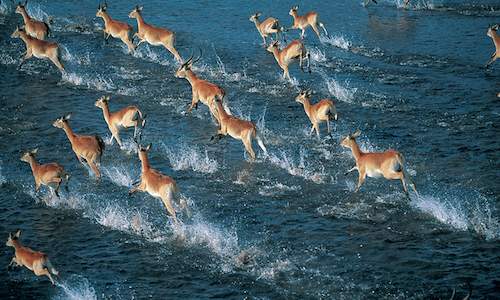
By Leigh Kemp
The species differences in different areas depend a great deal on habitat structure and climate patterns. As an example the Impala of East Africa are larger in body and horn structure than the Southern Africa animals.In southern Africa there is one mating season and it lasts for a few weeks whereas in east Africa the mating season continues for most of the year, with two peaks in activity, as the climatic conditions are more favourable for this, ensuring that the competition is far greater and the animals have to be fitter and stronger.Of Deserts and Wetlands
The colour shades of species will vary due to the habitat. Leopard occurring in desert and semi desert will generally have a lighter shade than ones occurring in wooded areas allowing for blending into the environment.
Individuals of the same species show differing habits in dry desert areas than in well-watered areas. Animals of the dry areas such as the Central Kalahari do not drink water but rather get their liquid needs from the food they eat whereas those in area such as the Okavango Delta will drink water every day.
Favoured Prey
Predator habits vary across areas of distribution as the prey is different. Lions hunt a variety of prey in most regions they occur but there is usually a favoured species. In areas of South Africa Lions are hesitant to hunt Buffalo, and yet in many other parts of Africa Buffalo is the preferred prey species.
In many areas of their distribution these individuals or groups of these species have adapted to hunting a specific prey - for example a pride of Elephant killing Lions in Northern Botswana has adapted to killing adult Elephant while another pride not fifty km away has adapted to killing Hippos. Both these were predator/prey interactions that had never that had never been recorded until recently.
Climate and Breeding Seasons
Antelope species will have a defined breeding period during the year and in southern Africa this is generally determined by the seasons. The time of birth coincides with the first rains to allow for favourable conditions to prevail.
In some parts of Africa the birthing period may be year round for the same species. This is due to the conditions been favourable - sufficient food and water year round.
Man and Animal Migration
Man has played a huge role in species differentiation by controlling and managing wilderness areas. The Wildebeest are traditionally migratory animals and the Serengeti/Mara migrations continue today as they did centuries ago whereas the Wildebeest of southern Africa, (and in particular Botswana), have adapted to a non-migratory behaviour due to the interference of man.
Whether these animals have always been migratory is unknown but it could be that climatic conditions may have been the cause of the development of migratory behaviour in the past. Unnatural factors are now responsible for the cessation of this behaviour in most parts of Africa.

 This Botswana Wildlife Guide describes the various habitats from the Kalahari Desert to the Makgadikgadi Salt Pans, Linyanti Swamp and Okava...
This Botswana Wildlife Guide describes the various habitats from the Kalahari Desert to the Makgadikgadi Salt Pans, Linyanti Swamp and Okava...